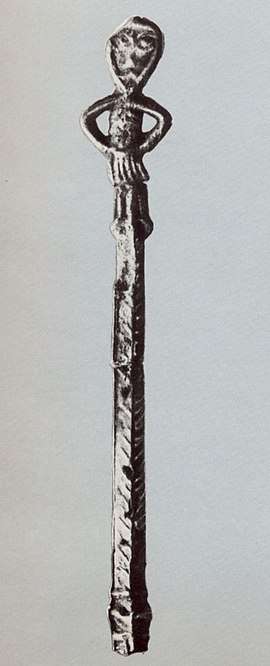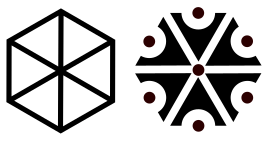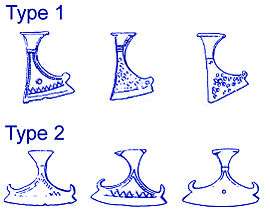Perun
In Slavic mythology, Perun (Cyrillic: Перýн) is the highest god of the pantheon and the god of sky, thunder, lightning, storms, rain, law, war, fertility and oak trees. His other attributes were fire, mountains, wind, iris, eagle, firmament (in Indo-European languages, this was joined with the notion of the sky of stone[2]), horses and carts, weapons (hammer, axe (Axe of Perun), and arrow), and war. He was first associated with weapons made of stone and later with those of metal.[3]
| Perun | |
|---|---|
spring, east, fertility, atmosphere, thunderbolt, warrior class / nobility | |
| Symbol | fire, oak, iris, eagle, hammer, mace or axe |
| Personal information | |
| Parents | Svarog and Lada |
| Consort | Mokosh or Perunika |
| Children | None |
| Equivalents | |
| Baltic equivalent | Perkūnas |
| Persian equivalent | Piran Viseh |
| Wikimedia Commons has media related to Perun. |
Sources
Of all historic records describing Slavic gods, those mentioning Perun are the most numerous. As early as the 6th century, he was mentioned in De Bello Gothico, a historical source written by the Eastern Roman historian Procopius. A short note describing beliefs of a certain South Slavic tribe states they acknowledge that one god, creator of lightning, is the only lord of all: to him do they sacrifice an ox and all sacrificial animals. While the name of the god is not mentioned here explicitly, 20th century research has established beyond doubt that the god of thunder and lightning in Slavic mythology is Perun.[4] To this day the word perun in a number of Slavic languages means "thunder," or "lightning bolt".

The Primary Chronicle relates that in the year 6415 (907 AD) prince Oleg (Scandin.: Helgi) made a peace treaty with the Byzantine Empire and by taking his men to the shrines and swearing by their weapons and by their god Perun, and by Volos, the god of cattle, they confirmed the treaty. We find the same form of confirmation of a peace treaty by prince Igor in 945. In 980, when prince Vladimir the Great came to the throne of Kiev, he erected statues of five pagan gods in front of his palace which he soon thereafter discarded after his Christianization in 988. Perun was chief among these, represented with a silver head and a golden moustache.[4](p133-) Vladimir's uncle Dobrinja also had a shrine of Perun established in his city of Novgorod. After the Christianization of Kievan Rus, this place became a monastery, which, quite remarkably, continued to bear the name of Perun.


Perun is not mentioned directly in any of the records of Western Slavic traditional religion, but a reference to him is perhaps made in a short note in Helmold's Chronica Slavorum, written in the latter half of the 12th century, which states (quite similarly to Procopius some six centuries earlier) that Slavic tribes, even though they worship many various gods, all agree there is a supreme god in heaven which rules over all other on earth. This could be a reference to Perun, but since he is not named, nor any of his chief attributes (thunder or lightning) mentioned, we cannot be certain.
Moreover, the name of Perun is also commonly found in Southern Slavic toponymy. The Bulgarian and Macedonian people believe that the name of the Bulgarian mountain Pirin, one of the highest mountains of the Balkan Peninsula, was named after Perun. Perun is also the name of the hill in Podstrana next to Split, Croatia. There are also places called: Perun (the famous mountain in Bosnia Herzegovina, Vareš), Perunac, Perunovac, Perunika, Perunička Glava, Peruni Vrh, Perunja Ves, Peruna Dubrava, Perunuša, Perušice, Perudina and Perutovac. The word "Pero" means feather and the names of mountains and cities could refer to poultry. These names today mostly represent mountain tops, but in medieval times, large oaks, sacred groves and even entire villages or citadels were named Perun. Among South Slavs, a mountain plant Iris germanica is known in folklore as perunika ("Perun's plant") and sometimes also as bogisha, ("god's plant"), and was believed to grow from ground that had been struck by lightning. Also the Serbian surname Peruničić and the Macedonian Перуновски (Perunovski) are derived from Perun.
The Bulgarian people believe that the name of city Pernik is thought to have originated from that of Slavic god Perun with the Slavic placename suffix –nik (or –ik) added, and was first mentioned in the 9th century. The medieval town was a key Bulgarian stronghold during Bulgarian tsar Samuil's wars against the Byzantine Empire in the 11th century, when it was governed by the local noble Krakra of Pernik, withstanding Byzantine sieges a number of times.
Some places in Central Europe possibly named after Perun are the villages of Parndorf (formerly known as Perun) and Pernitz in the Parndorf Plain, Perná in Moravia, Beroun in Bohemia, and Pernek in Slovakia.
Etymology
Perun is strongly correlated with the near-identical Perkūnas/Pērkons from Baltic mythology, suggesting either a common derivative of the Proto-Indo European thunder god (whose original name has been reconstructed as Perkwunos), or that one of these cultures borrowed the deity from the other. The root *perkwu originally probably meant oak, but in Proto-Slavic this evolved into per- meaning "to strike, to slay". The Lithuanian word "Perkūnas" has two meanings: "thunder" and the name of the god of thunder and lightning.
Artifacts, traditions and toponyms show the presence of the cult of Perun among all Slavic, Baltic and Ugro-Finnic peoples. Perun was also related to an archaic form of astronomy – the Pole star was called Perun's eye and countless Slavic and Hungarian astronomers continued this tradition – most known ones are Nicolaus Copernicus, and Franz Xaver von Zach.
Myth
In Slavic mythology, much like in Norse and Baltic mythologies, the world was represented by a sacred tree, usually an oak, whose branches and trunk represented the living world of heavens and mortals, whilst its roots represented the underworld, i.e. the realm of the dead. Perun was the ruler of the living world, sky and earth, and was often symbolised by an eagle sitting on the top of the tallest branch of the sacred tree, from which he kept watch over the entire world. Deep down in the roots of the tree was the place of his opponent, symbolised by a serpent or a dragon: this was Veles, watery god of the underworld, who continually provoked Perun by creeping up from the wet below up into the high and dry domain of Perun, stealing his cattle, children, or wife. Perun pursued Veles around the earth, attacking him with his lightning bolts from the sky. Veles fled from him by transforming himself into various animals, or hiding behind trees, houses, or people; wherever a lightning bolt struck, it was believed that this was because Veles hid from Perun under or behind that particular place. In the end, Perun managed to kill Veles, or to chase him back down into his watery underworld. The supreme god thus reestablished order in the world, which had been disrupted by his chaotic enemy. He then returned to the top of the World tree and proudly informed his opponent down in the roots "Well, there is your place, remain there!" (Ну, там твое место, там сабе будь!). This line came from a Belarusian folk tale. To the Slavs, the mythological symbolism of a supreme heavenly god who battles with his underworldly enemy through storms and thunder was extremely significant.
While the exact pantheon characterization differed between the various Slavic tribes, Perun is generally believed to have been considered as the supreme god by the majority, or perhaps by nearly all Slavs, at least towards the end of Slavic paganism. The earliest supreme god was probably Rod; it is unclear precisely how and why his worship as the head of the pantheon evolved into the worship of Perun. Another candidate for supreme deity among at least some Slavs is Svarog.
Weapons
In the classification scheme of Georges Dumézil, Perun was the god of the second function (physical and military power), a god of war, and as such, he was armed with several fantastic weapons. Perun's lightning bolts were believed to be stones and stone arrows. According to folk beliefs, fulgurites, belemnites, and sometimes even the remains of prehistoric stone tools found in the ground are remains of these weapons. Various Slavic countries also call these deposits "Perun's stones", "thunderbolt stones", "thunderbolt wedges" and "Perun's arrow"; other unrelated names for these include "devil's finger", "God's finger", and "Mother of God finger", and in Lithuania, "Perkun's finger" (Belemnitida). These thunderbolt stones were sometimes said to be transferred back to the sky by the wind after being under earth for a period of seven years. The weapons of Perun protected against bad luck, evil magic, disease, and – naturally enough – lightning itself.
Perun also had another type of weapon in his arsenal, as destructive as his firestone arrows, but even more unusual: mythical golden apples. While this may not seem to be much of a weapon, in many Slavic folk accounts, the golden apple appears as a talisman of ultimate destruction. An example from a Serbian folk song from Montenegro with strong mythical elements relates:
…Те извади три јабуке златне
И баци их небу у висине...
…Три муње од неба пукоше
Једна гађа два дјевера млада,
Друга гађа пашу на дорину,
Трећа гађа свата шест стотина,
Не утече ока за свједока,
Ни да каже, како погибоше.
"…He grabbed three golden apples
And threw them high into the sky...
…Three lightning bolts burst from the sky,
The first struck at two young grooms,
The second struck pasha on brown horse,
The third struck six hundred wedding guests,
Not an eyewitness left
Not even to say how they died."
It is conjectured that the mythical golden apples of Perun were symbols of a rare but notorious form of atmospheric discharge, ball lightning. The same is probably true for the thunder marks of East Slavic folklore, of which two examples are shown above.
Characteristics
Remains of an ancient shrine to Perun discovered in Peryn consisted of a wide circular platform centred around a statue, encircled by a trench with eight apses, which contained sacrificial altars and possibly additional statues. The overall plan of the shrine shows clear symbolism of the number nine. This is sometimes interpreted that Perun, in fact, had nine sons (or eight sons, with himself, the father, being the ninth Perun). In some Slavic folk songs, nine unnamed brothers are mentioned.
Similarly to Perkūnas of Baltic mythology, Perun was considered to have multiple aspects. In one Lithuanian song, it is said there are in fact nine versions of Perkūnas. From comparison to the Baltic mythology, and also from additional sources in Slavic folklore, it can also be shown that Perun was married to the Sun. He, however, shared his wife with his enemy Veles, as each night the Sun was thought of as diving behind the horizon and into the underworld, the realm of the dead over which Veles ruled.
Like many other Indo-European thunder gods, Perun's vegetative hypostasis was the oak, especially a particularly distinctive or prominent one. In Southern Slavic traditions, marked oaks stood on country borders; communities at these positions were visited during village holidays in the late spring and during the summer. Shrines of Perun were located either on top of mountains or hills, or in sacred groves underneath ancient oaks. These were general places of worship and sacrifices (with a bull, an ox, a ram, and eggs).
In addition to the tree association, Perun had a day association (Thursday) as well as the material association (tin).[6]
Post-Christian Perun
With the arrival of Christianity, the old gods fared poorly amongst the Slavs. Grand prince Vladimir the Great, who had once been a very vocal and lavish patron of Perun, converted to Christianity. In 998 he, his family and the people of the Kievan Rus' were collectively baptized. He ordered that the statues of Perun which he himself had erected formerly, be dethroned, torn down with great dishonor and dragged through the streets as they were beaten with sticks. The idols were then cast into rivers and not permitted to land on the shore.[7] Three of Vladimir's sons are also recognized as saints. Modern scholarship on the syncretism (or dvoeverie) of the Christian and pagan gods seems to be more of an academic construct.
See also
References
- Katičić, Radoslav (2014). Vilinska Vrata: I dalje tragovima svetih pjesama naše pretkršćanske starine (in Croatian). Zagreb: IBIS GRAFIKA/Matica hrvatska. pp. 62–64. ISBN 978-953-6927-83-8.
- Gamkrelidze, Thomas V.; Ivanov, Vjaceslav V. (1995). Indo-European and the Indo-Europeans: A Reconstruction and Historical Analysis of a Proto-Language and a Proto-Culture. Berlin, New York: Mouton de Gruyter. pp. 575. ISBN 3-11-009646-3.
- "Encyclopedia of Russian & Slavic Myth and Legend – Mike Dixon-Kennedy – Google Książki".
- Katičić, Radoslav (2008). Božanski boj: Tragovima svetih pjesama naše pretkršćanske starine (PDF). Zagreb: IBIS GRAFIKA. ISBN 978-953-6927-41-8. Archived from the original (PDF) on 2015-10-18.
- Encyclopedia of Ukraine, vol. 3 (1993)
- "Боги славян" (in Russian). Энциклопедия славянской религии. Retrieved 2019-07-06.
- "Prince Vladimir and baptism of Russians". Retrieved 2019-07-06.
Further reading
- Perun, Dieu slave de l'orage. Archéologie, histoire, folklore, by Patrice Lajoye; Lingva (France) (2015)
- Perun: The God of Thunder by Mark Yoffe and Joseph Krafczik; Peter Lang Publishing (April 2003)
- Graves, Robert: New Larousse Encyclopedia Of Mythology (Hardcover), Crescent (December 16, 1987)
- Ryan, W. F.:The Bathhouse at Midnight: An Historical Survey of Magic and Divination in Russia (Magic in History Series) (Paperback), Pennsylvania State University Press (September 1999)
- Znayenko, Myroslava T.: The gods of the ancient Slavs: Tatishchev and the beginnings of Slavic mythology (Paperback), Slavica (1980)
- Yoffe, Mark; Krafczik, Joseph: Perun: The God of Thunder (Studies in the Humanities (New York, N.Y.), V. 43.) (Hardcover), Peter Lang Publishing (April 2003)